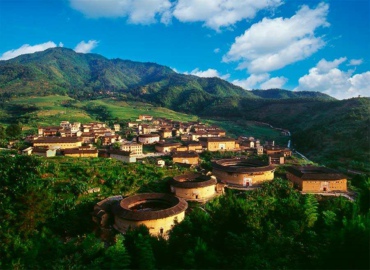Xiamen
Xiamen Overview
Xiamen (Amoy), affiliated to Fujian Province, it is known as the island of egret. It is a deputy provincial city and special economic zone in China. As an important central port city in China’s southeast coast, ports, Xiamen is also a beautiful and popular tourism destination.

Hot
- 8 Hours
One day Xiamen and Gulangyu highlight tour
Explore Xiamen, the beautiful coastal city of southeastern China. Visit the World Heritage cultural site-Gulangyu Island.
From $78

- 9 Hours
Private one day Xiamen culture and history tour
Experience the daily life of local Xiamen people, explore the old quarter of Xiamen and learn the morden history of Xiamen.
From $53

- 5 hours
Xiamen Layover Tour-Gulangyu,Shuzhuang Garden And Sunlight Rock
A VISA-free private day tour that specially designed for travelers who have 5~12 hours layover in Xiamen.
From $60

Hot
- 4 days
4-day Xiamen and Hakka Earth Building Tour
Classic Xiamen and Hakka Earth Building tour to Chuxi Tulou Cluster by professional local expert.
From $276

Hot
- 2 days
2-day Private Fujian Tulou Exploration Tour to Nanjing and Yongding
This tour covers the most worth-seeing tulou clusters-Tianluokeng Tulou in Nanjing and Hongkeng Tulou in Yongding with authentic local family visit.
From $149

Hot
- 2 days
2-day Xiamen and Gulangyu highlight tour from Hong Kong
Take a high speed train from Hong Kong to Xiamen for only 4 hours and enjoy the highlights of Xiamen and Gulangyu Island.
From $298

Hot
- 8 hours
One day Jimei Culture Highlight Tour from Xiamen
Experience the cultural Jimei District and admire the live performance--Legend of Minnan Show.
From $65
Xiamen consists of Xiamen Island, the Gulangyu Island, the west coast Haicang Peninsula, the north shore Jimei Peninsula, the east coast Xiang'an Peninsula and the inland Tongan District. The land area is about 1700 square kilometers and the sea area is over 390 square kilometers.
In the 21st century, Xiamen has gradually become a modern international port and tourist city with world cultural heritage- Gulangyu Island.
Some facts about Xiamen
Chinese name: 厦门
English name: Xiamen, Amoy, Hsiamen
Local dialect: Min Nan dialect (south Fujian dialect) and Chinese mandarin
Area: 1700 km²;
Population: 4.01 million (2017)
Climate: Subtropical maritime monsoon climate
Attractions: Gulangyu Island, South Putuo Temple, Hulishan Fortress, Island Ring Road, Wanshi Botanic Garden, Jimei School Village, etc
Best time to visit Xiamen: suitable for travel all the year round, and the best time is in spring and autumn, especially from April to November every year.
Popular sights in Xiamen
South Putuo Temple: It was first built in Tang Dynasty with over 1000 years of history and famous for its rich Buddhist cultural relics collection. Climbing up the Wulao Peak behind the temple, have a magnificent bird-view of Xiamen port.
Hulishan Fortress: Built in the year of 1891, the Hulishan Fortress integrated the styles of Ming and Qing Dynasties. The ancient military facilities (such as the gates, walls, emplacements, the barracks, the castle, the trenches and fortifications) built with high-quality granites are well-preserved and are also valuable historical relics for the study of China's maritime defense history, Westernization Movement history and military construction techniques.
Gulangyu Island: It was a foreign enclave from the 1840s until the 1930s, and is now both a residential suburb and a major tourist area. Integrated history, culture and natural scenery, it was inscribed as a UNESCO World Heritage Site in 2017. Called “the garden on the sea”, Gulangyu has more than 40% green land coverage and abundant plant populations. Filled with the charming colonial buildings such as churches, consulates, etc, Gulangyu is no doubt a museum of "Architecture of the World".
Sunlight Rock: the highest peak on Gulangyu Island. Visit Sun Light Temple and admire the bird eye view of this tranquil island.
Shuzhuang Garden, the unique seaside garden on Gulangyu Island. Covering an area of more than 3,000 square meters, Shuzhuang Garden was first built in 1913 by the rich Taiwanese merchant Lin Shuzhuang. Continue visit to the world-class Piano Museum in Shuzhuang Garden which is the only piano museum in China.
Island Ring Road: The most beautiful Marathon track in China. It is the perfect place to relax at the clean beaches and seashore plazas.
Xiamen Botanic Garden: Xiamen Botanical Garden, commonly known as “Wanshi Botanical Garden”, is carefully designed around Wanshiyan Reservoir. The park includes more than 20 specialized gardens and planting areas, such as pine cedar garden, rose garden, palm garden, large cactus garden, Baihua Hall, and orchid pot. More than 6,000 tropical and subtropical plants have been cultivated.
Jimei School Village: It is a collective name for various types of schools and cultural institutions in Jimei. It was founded by a famous patriotic overseas Chinese leader Mr. Tan Kah Kee in 1913 and was established both at home and abroad. The agglutination of the beautiful scenery, the building blends Chinese and Western style, embodies the typical architecture of overseas Chinese in southern Fujian. In September 2016, Jimei Village was selected as “the first Chinese architectural heritage of the 20th century”.